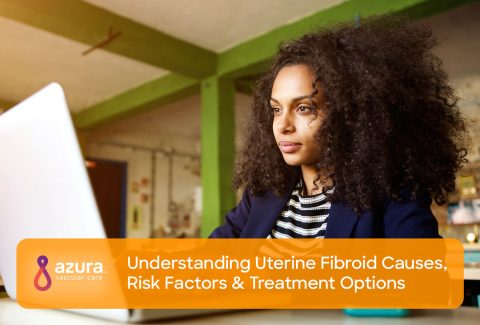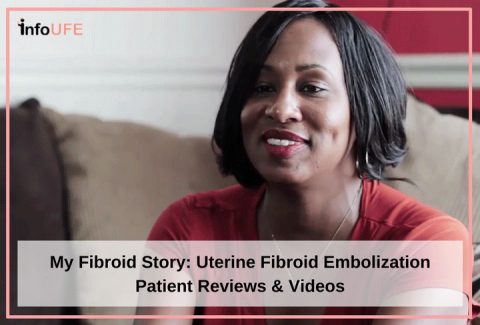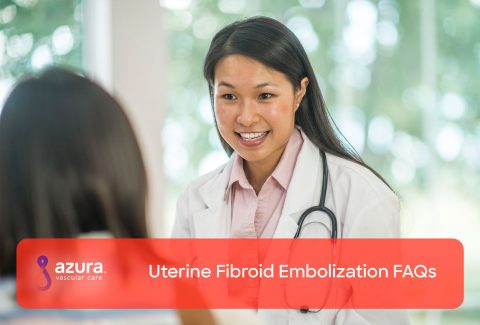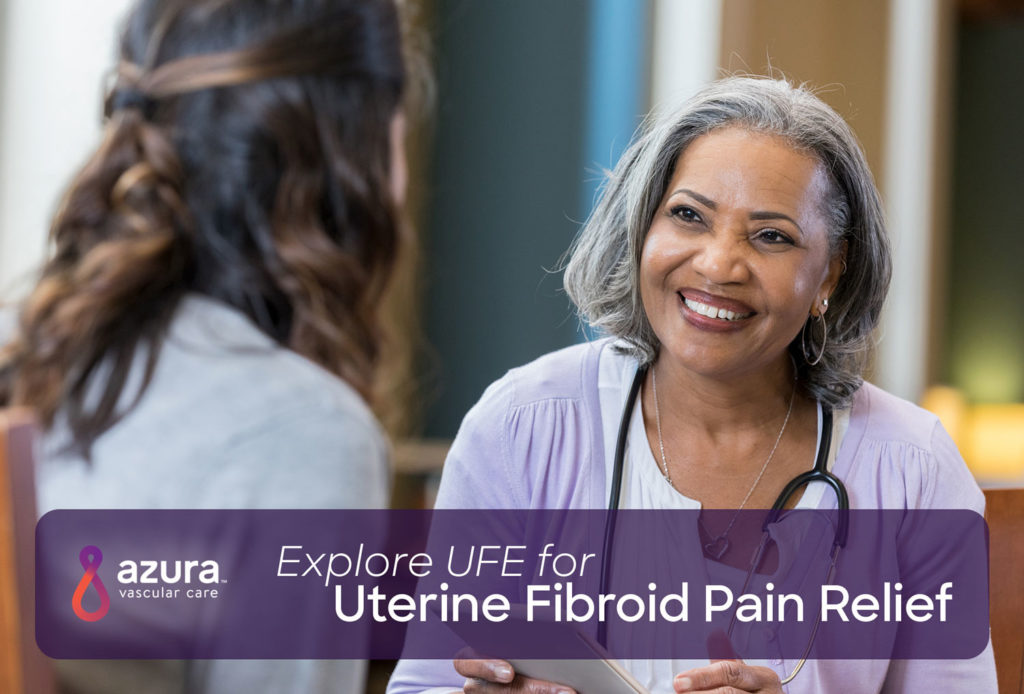
In many cases, uterine fibroids don’t cause any issues. However, for some, pain and bleeding due to fibroids can affect quality of life. If you are suffering from symptomatic uterine fibroids, a good treatment option for fibroid pain relief is uterine fibroid embolization (UFE).
UFE is a minimally invasive outpatient procedure that uses a form of real-time X-ray called fluoroscopy to guide the delivery of small particles to the uterine blood vessels and fibroids. As tiny as grains of sand, they are injected through a thin, flexible tube called a catheter. The small particles block the arteries that provide blood flow, depriving the fibroids of nutrients and causing them to shrink.
Studies have shown that nearly 90 percent of women who have UFE experience significant improvement or no longer have fibroid-related symptoms (i). The UFE procedure is an option for women who want or need to avoid having a hysterectomy, an operation that removes the uterus.
UFE Benefits
There are several benefits of UFE over more invasive treatments such as hysterectomy and other alternatives to hysterectomy: (i)
- UFE is much less invasive than open or laparoscopic surgery (myomectomy) or hysterectomy.
- UFE recovery time is much shorter—patients should be able to resume their activities much earlier than if they had surgery.
- There is no surgical incision and virtually no blood loss—only a small nick in the skin is required.
- General anesthesia isn’t required.
- All fibroids can be treated during a single procedure.
- It’s rare for treated fibroids to regrow or for new fibroids to develop after UFE.
- It’s a more permanent solution than hormone therapy since tumors usually regrow once hormonal treatment stops.
Who Is a Candidate for UFE?
Your doctor may recommend UFE if you have: (ii)
- Excessive bleeding due to fibroids.
- Pain or fullness in your belly.
- An enlarged uterus.
- Pain during intercourse.
- A belly that’s larger than normal.
- Infertility.
- Bladder pressure that makes you feel like you need to urinate often.
- Pressure on the bowel that causes constipation and bloating.
- Pain in your back or legs, which could be caused by fibroids pressing on your nerves.
UFE is a great option for those seeking fibroid pain relief or relief from other complications of uterine fibroids. However, UFE isn’t appropriate for patients with an active pelvic infection, when cancer is a possibility, if uterine fibroids are extremely large, or if the patient is pregnant. (iii)
What to Expect During UFE
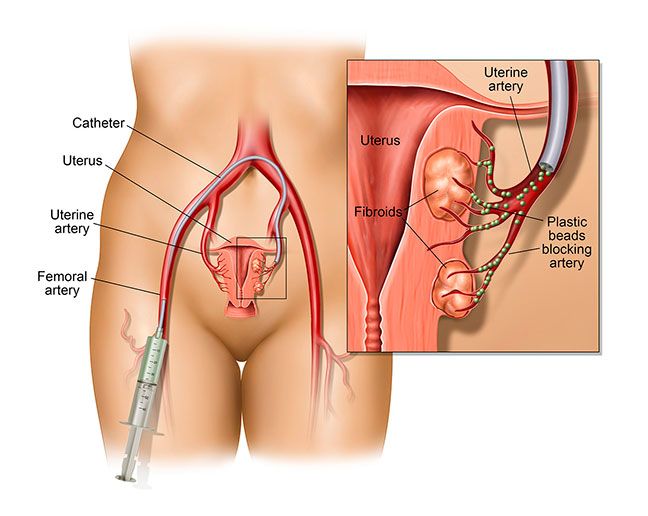 The minimally invasive UFE procedure is easily performed in an outpatient setting by an interventional radiologist, a specialist who treats conditions with minimally invasive procedures. These practitioners use small instruments plus imaging equipment like X-rays, CT scans, MRI, fluoroscopy or ultrasound.
The minimally invasive UFE procedure is easily performed in an outpatient setting by an interventional radiologist, a specialist who treats conditions with minimally invasive procedures. These practitioners use small instruments plus imaging equipment like X-rays, CT scans, MRI, fluoroscopy or ultrasound.
During the procedure, a nurse or technologist may insert an intravenous (IV) line into a vein in the hand or arm to deliver a mild sedative. The area of the body where the catheter will be inserted will be sterilized and covered with a surgical cloth. The physician will numb that area with a local anesthetic before making a very small skin nick at the site.
Using fluoroscopy to visualize the arteries, a catheter will be inserted into the femoral artery located in the groin area. Injection of contrast via the catheter will create a map for the catheter as it’s guided into the affected uterine arteries. Small particles are then released using the catheter. At the end of the procedure, the catheter will be removed and pressure will be applied to the puncture site to stop any bleeding. The nick in the skin will be covered with a dressing; no sutures are needed. Lastly, the IV line, if placed, will be removed.
What to Expect After UFE
After the UFE procedure, a nurse will review discharge instructions with you and provide prescriptions for pain and anti-nausea medication for your recovery at home. It is normal to experience pain, mild fever and nausea for a few days after the procedure.
You should notice several changes after the UFE procedure: (i)
- For the first 24 hours after UFE, you may experience pelvic cramps, but they will improve rapidly over the next few days, and you should be able to return to your normal activities within one to two weeks.
- It’s common for menstrual bleeding to be much less severe during your first cycle after UFE. It should gradually increase.
- You may miss a cycle or two or, in rare cases, stop having periods altogether.
- Relief from bulk- or size-related symptoms such as pelvic pressure and difficulties urinating can take two to three weeks as fibroids continue to shrink and soften, and fibroids no longer put pressure on nearby pelvic organs.
To learn more about fibroids and UFE, call 844-UFE-CARE (833-2273) today to schedule an appointment with a vascular specialist.
Sources:
(i) Radiological Society of North America. (2018, February 25). Uterine fibroid embolization (UFE). Retrieved December 11, 2018, from https://www.radiologyinfo.org/en/info.cfm?pg=ufe.
(ii) Johns Hopkins Medicine. (n.d.). Uterine artery embolization. Retrieved December 11, 2018, from https://www.hopkinsmedicine.org/healthlibrary/test_procedures/gynecology/uterine_artery_embolization_92,p08484.
(iii) Johns Hopkins Medicine. (n.d.). Is uterine fibroid embolization (UFE) the right treatment for you? Retrieved December 11, 2018, from https://www.hopkinsmedicine.org/health/healthy-woman/conditions/is-uterine-fibroid-embolization-ufe-the-right-treatment-for-you.

